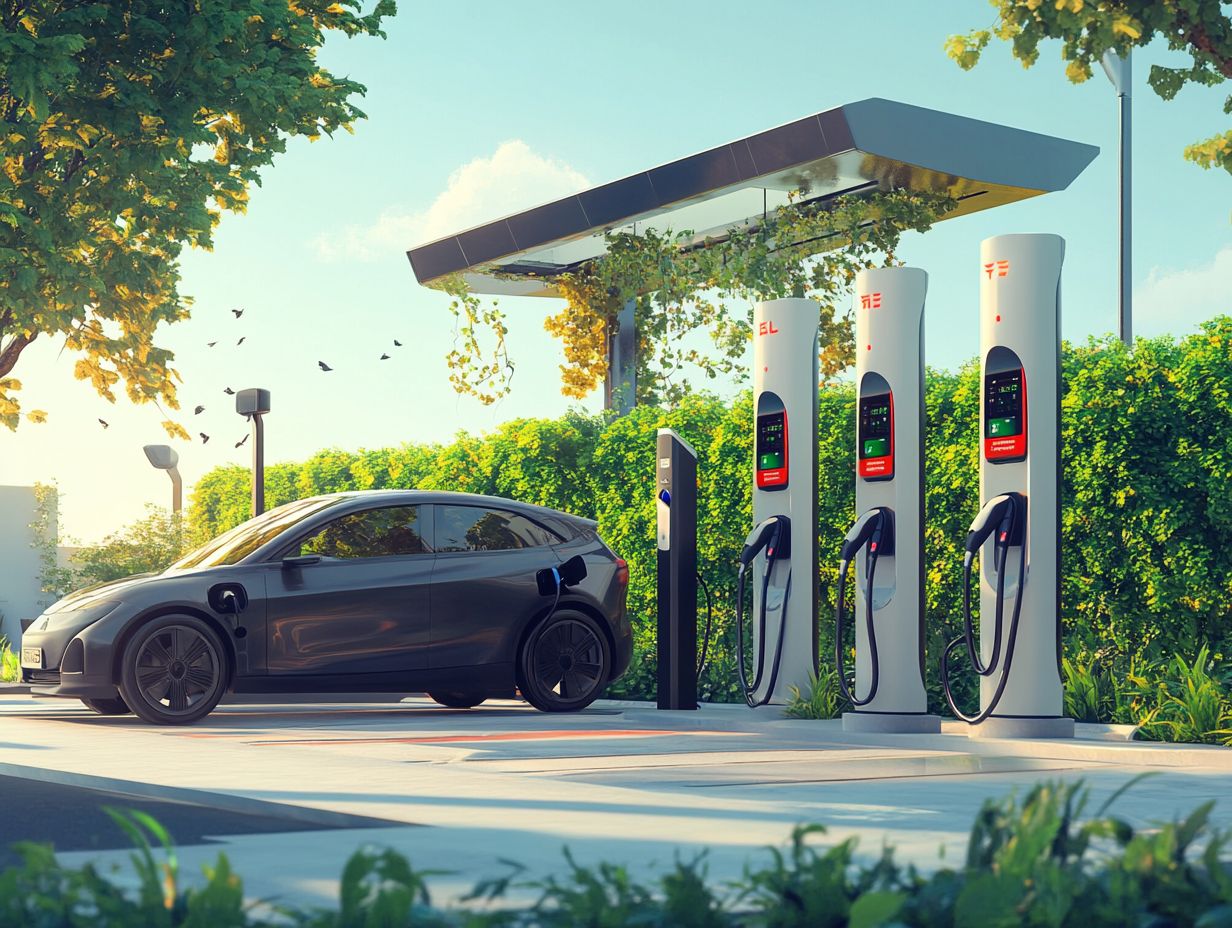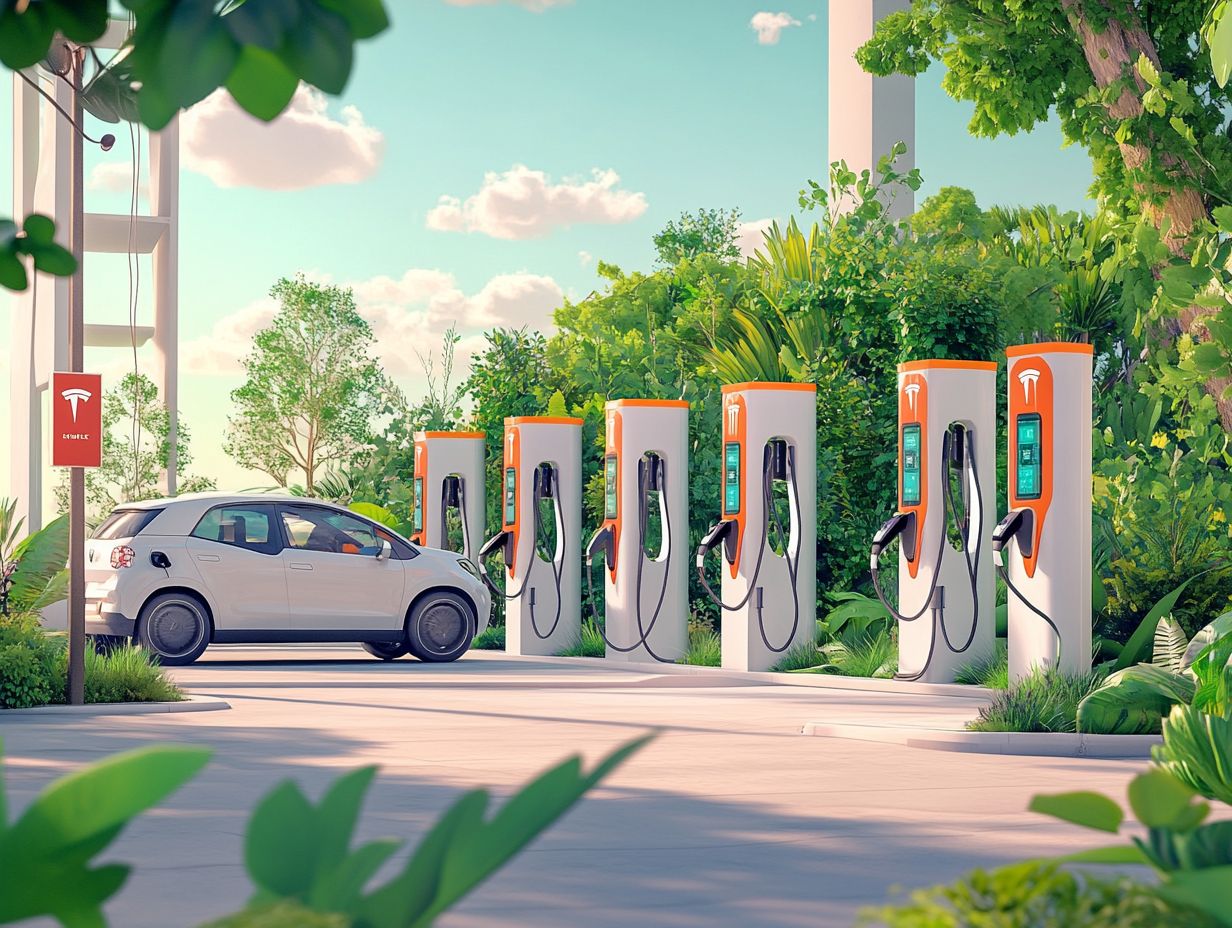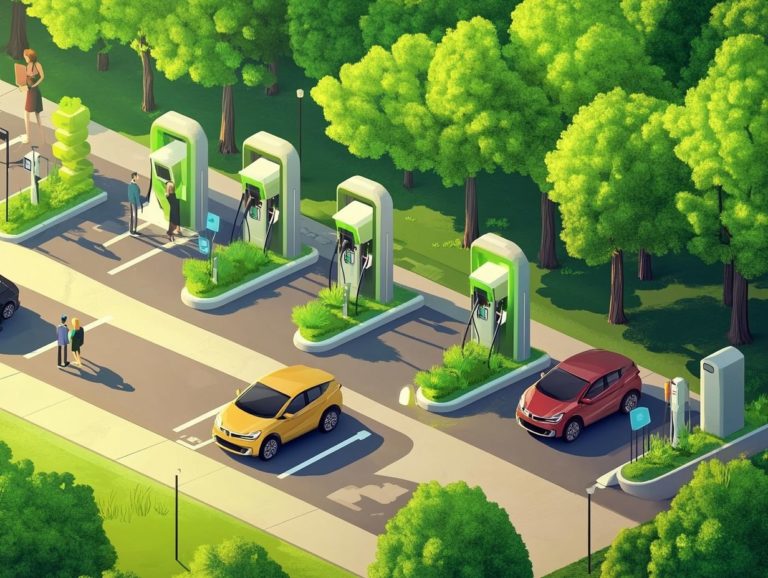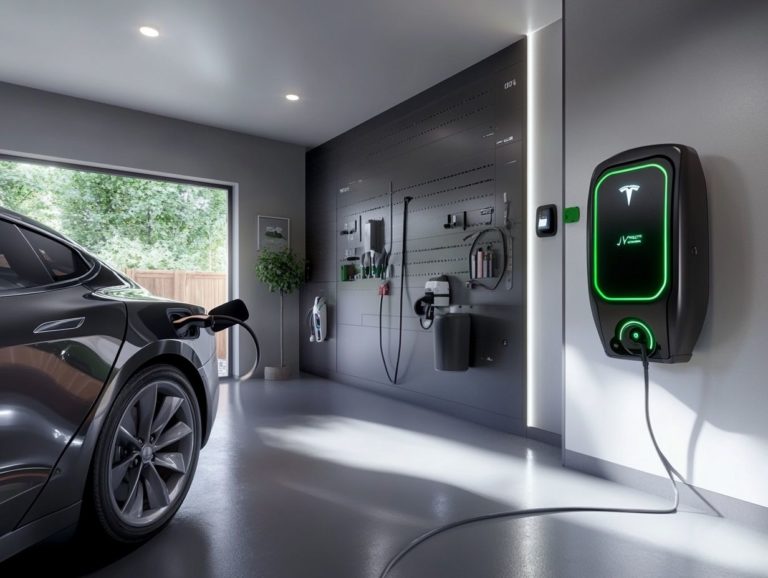Charging Infrastructure: What You Need to Know
As electric vehicles (EVs) gain remarkable traction in today’s world, understanding the details of charging infrastructure becomes indispensable for both consumers and businesses alike.
This article delves into the diverse array of charging options available to you, from public stations to home solutions, while showcasing the myriad benefits they offer ranging from environmental advantages to significant cost savings.
You ll also learn about key factors to consider prior to installation and gain insights into the future of charging technology.
Engage with us as you navigate the intricate landscape of charging infrastructure!
Contents
- Key Takeaways:
- Defining Charging Infrastructure
- Types of Charging Infrastructure
- Benefits of Charging Infrastructure
- Factors to Consider Before Installing Charging Infrastructure
- Future of Charging Infrastructure
- Frequently Asked Questions
- What is charging infrastructure and why is it important?
- What types of charging options are available for electric vehicles?
- Do I need to install charging infrastructure at home?
- Are there different types of charging connectors for electric vehicles?
- How do I find charging stations for my electric vehicle?
- What should I consider when installing charging infrastructure at my business?
Key Takeaways:

- Charging infrastructure is necessary for electric vehicles to thrive, and it can be divided into public stations and home solutions.
- Investing in charging infrastructure has both environmental and practical benefits, including reduced emissions and cost savings.
- Consider factors like location, cost, and future expansion plans before installing charging infrastructure.
Defining Charging Infrastructure
Charging infrastructure is essential for the widespread adoption of electric vehicles (EVs). It encompasses a range of systems and technologies that support EV charging, including public charging stations and home solutions, as detailed in how charging infrastructure is evolving globally.
This includes the deployment of DC fast charging, Level 2 chargers, and innovative logistics designed to meet consumer needs while addressing infrastructure investment. As the demand for charging infrastructure increases, understanding what you should know about EV charging networks becomes vital for you as a stakeholder, ensuring equitable access and effective deployment within communities.
This infrastructure helps reduce greenhouse gas emissions. It promotes EV usage, which has a smaller carbon footprint than traditional vehicles. It also alleviates range anxiety a common concern among potential EV users by providing a reliable network of charging options.
You ll find various types of charging equipment, including home wall chargers, public fast stations, and renewable energy-integrated chargers, catering to diverse consumer preferences. Charging network providers work to ensure these systems are interconnected and user-friendly, creating a seamless experience for you.
Federal funding plays a crucial role in supporting the development of necessary infrastructure and encouraging private investments. This ultimately fosters a robust ecosystem that adapts to the evolving needs of electric mobility.
Types of Charging Infrastructure
You’ll discover a range of charging infrastructure tailored to the diverse needs of electric vehicle users, including public charging stations, home charging solutions, and varying charging levels like Level 2 and DC fast charging. Understanding how charging infrastructure affects sustainability is crucial for making informed choices.
Each option is designed to cater specifically to different charging behaviors and requirements, ensuring that your electric vehicle experience is as seamless and convenient as possible.
Public Charging Stations
Public charging stations are essential to the electric vehicle ecosystem. They provide crucial access for those without home charging solutions and help alleviate concerns about range anxiety while promoting the adoption of electric vehicles.
Strategically positioned in urban centers, shopping districts, and along major highways, these stations ensure that drivers can easily find a place to charge. You’ll typically encounter various charging options here, from Level 2 chargers in parking lots to DC fast chargers that can significantly cut down on your charging time.
These public stations seamlessly integrate into a larger charging network, supporting not only individual users but also enhancing local economies by drawing customers to nearby businesses. It’s worth noting that the cost of using public chargers can vary. Consumer reports indicate an average price of around $0.30 per kWh, making it vital for you to understand pricing structures in your area to ensure equitable access.
Home Charging Solutions
Home charging solutions, especially Level 2 chargers, empower electric vehicle owners like you to charge your vehicle conveniently and efficiently. This option often proves to be more cost-effective than relying on public charging stations.
By installing a home charging unit, you can effortlessly manage your vehicle’s energy needs without depending on external infrastructure. The installation typically requires a dedicated 240-volt outlet, making the process quite straightforward for most homeowners.
This home setup not only streamlines your charging logistics no more searching for public stations but also fosters more consistent charging habits. Many owners discover that charging overnight leads to significant savings on electricity bills, particularly when capitalizing on off-peak utility rates.
A range of government incentive programs and federal funding options help offset installation costs, making the shift to home charging even more enticing.
Benefits of Charging Infrastructure

The advantages of a robust charging infrastructure reach far beyond mere convenience and cost efficiency. It plays a crucial role in enhancing environmental sustainability by significantly reducing greenhouse gas emissions.
It also promotes public health benefits associated with improved air quality, ensuring a cleaner, healthier environment for everyone.
Environmental Benefits
The environmental advantages of charging infrastructure are profound. It significantly aids your transition to electric vehicles (EVs), which are crucial for minimizing greenhouse gas emissions and enhancing energy efficiency throughout transportation networks.
This infrastructure encourages the adoption of battery electric vehicles and plug-in hybrids. It also motivates consumers like you to make the switch. A study from the International Council on Clean Transportation reveals that regions with robust charging networks have seen a notable surge in EV adoption, resulting in considerable reductions in air pollutants.
Charging stations are more than mere conveniences; they are vital elements in a broader ecosystem aimed at improving public health through cleaner air. By facilitating the shift to renewable energy sources, the future of EV charging infrastructure development paves the way for a more sustainable future, giving power to communities to utilize cleaner energy and contribute to environmental preservation.
Convenience and Cost Savings
Embracing electric vehicles can save you money and offer unmatched convenience! This setup provides flexible charging options that can ultimately lead to lower overall costs compared to traditional gasoline vehicles.
The infrastructure enhances your accessibility by offering diverse payment structures like pay-per-use, subscription models, or even free charging in select locations. This flexibility is particularly advantageous if you reside in urban areas, where charging stations are increasingly woven into lifestyle hubs like shopping centers and workplaces. However, it’s important to recognize the challenges of charging infrastructure expansion that may still arise.
Regional cost variations can significantly impact your decisions; some states, for instance, offer rebates or incentives for home charging installations, leading to potential long-term savings for you.
Many electric vehicle owners have shared their positive experiences, highlighting how easy it is to find chargers and the convenience of mobile app payments.
Surveys reveal that a significant portion of electric vehicle users feel heightened satisfaction with their vehicles, thanks to the reliable charging options available. This assurance promises a smoother transition to sustainable driving for you.
Factors to Consider Before Installing Charging Infrastructure
Now is the time to consider location, accessibility, installation costs, and ongoing maintenance for your charging setup!
Each of these elements plays a significant role in determining the effectiveness and efficiency of your charging network.
Location and Accessibility
The location and accessibility of charging infrastructure are crucial for you, the electric vehicle user, to effortlessly access public charging stations and home charging solutions. Understanding the impact of charging infrastructure on EV adoption ultimately shapes the broader acceptance of electric vehicles in the market.
Strategic location planning is key. It not only enhances your convenience but also greatly increases trust in electric vehicles. As a charging network provider, collaborating seamlessly with local governments and community stakeholders is essential. This partnership helps identify the best locations that conform to zoning laws (rules that determine how land can be used) and local regulations. This ensures that charging stations are situated near high-traffic areas and residential neighborhoods for your easy access.
By engaging with the community, providers can gain insights into your specific needs. This leads to tailored charging solutions that address local demands and nurture a positive attitude toward sustainable transportation.
Cost and Maintenance

The cost and maintenance of charging infrastructure can vary significantly, influencing the overall feasibility of installing charging stations and the sustainability of the charging network across different regions.
This variability is shaped by a multitude of factors, including geographic location, local regulations, and the technology utilized. For example, if you re in an urban area, you may encounter higher installation costs due to land scarcity. In contrast, rural locations might grapple with limited funding resources. Beyond the initial setup, ongoing maintenance expenses can shift depending on usage levels and weather conditions.
You ll find that various payment structures, such as leasing options or pay-per-use models, can help alleviate upfront costs. Don t miss out on federal funding opportunities that can ease your financial burden. Federal funding initiatives aimed at improving renewable energy infrastructure may provide chances to lessen financial pressures for both individuals and electric utilities, ultimately fostering the broader adoption of these essential technologies.
Future of Charging Infrastructure
The future of charging infrastructure is about to transform significantly, driven by cutting-edge technological advancements and EV charger compatibility considerations in visionary expansion plans.
These initiatives are designed not only to meet electrification goals but also to elevate the overall electric vehicle charging experience to new heights.
Technological Advancements and Expansion Plans
Technological advancements in charging infrastructure are setting the stage for more efficient and user-friendly electric vehicle charging solutions. Ambitious expansion plans are designed to enhance the reach and functionality of the charging network.
Get ready for exciting innovations like wireless charging capabilities that remove the hassle of cables, making your charging experience effortlessly seamless. Vehicle-to-grid technology allows electric cars to send power back to the grid when demand is high.
Improved payment structures, including subscription models and mobile payment solutions, are emerging to simplify transactions for you.
As these technologies continue to evolve, electric utilities and charging network providers will be better equipped to meet your increasing demand for fast and convenient access, ultimately fostering a more sustainable and effective energy ecosystem.
Frequently Asked Questions
What is charging infrastructure and why is it important?
Charging infrastructure refers to the network of charging stations and equipment that supply electricity to electric vehicles. It is important because it allows EV owners to charge their vehicles conveniently and reliably. For those considering this option, installing a home EV charger can significantly encourage the adoption of electric vehicles.
What types of charging options are available for electric vehicles?

Electric vehicles have three main charging options: Level 1, Level 2, and DC fast charging. Level 1 uses a standard household outlet, while Level 2 offers a faster charge with higher voltage. DC fast charging is the quickest option, found at public stations.
Do I need to install charging infrastructure at home?
You don’t have to install charging infrastructure at home. However, it can be convenient and cost-effective for daily use. For those considering an electric vehicle, checking out EV buying tips is helpful, as public charging stations are also available for longer trips or emergencies.
Are there different types of charging connectors for electric vehicles?
Yes, different connectors exist for various charging options. For Level 1 and Level 2, the J1772 connector is common. DC fast charging uses CHAdeMO or CCS connectors. Tesla vehicles have a unique connector for their Supercharger network.
How do I find charging stations for my electric vehicle?
Several websites and apps can help you locate charging stations. Check out PlugShare, ChargeHub, or ask your electric vehicle manufacturer for their recommended locator.
What should I consider when installing charging infrastructure at my business?
When setting up charging stations at your business, think about location, accessibility, and the number of stations needed. Ensure compliance with safety and regulatory requirements too.




